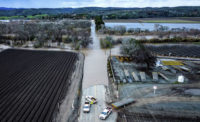Odebrecht Pushes forward With Next Phase of Peruvian Irrigation Project




























As the works to complete the dam and tunnel that will divert water across the Andean Continental Divide in northern Peru struggle toward completion, the Brazilian company handling the job� is already preparing for the next phase of the project.
La Concesionaria Trasvase Olmos S.A., a business entity created solely for the project by general contract Odebrecht Peru, is seeking the 20-year contract that will divert the waters from the Los Olmos project to irrigate 38,000 hectacres on the arid Pacific coast.
On May 11, Peruvian President Alan Garcia signed the document clearing the way for the regional government of the Dept. of Lambayeque to proceed with the proposal.
"Today we have the green light for you to sign the contract as soon as possible and start work,"�said Garcia at a ceremony in the department's capital city, also named Lambayeque.
The signing allows the regional government to enter into the contract with the concessionaire while also formalizing the national government's financial backing of the enterprise. Marco Cardoso, Lambayeque Dept. president, says he'll sign the contract by the end of May.
Odebrecht is already working on the $247-million initial phase of the project that includes the construction�of the Limón Dam on the Huancabamba River near the village of San Felipe. The contractor is boring a 20.2-kilometer-long tunnel through the mountains.
The firm constructed a 43-meter-high, roller-compacted concrete dam in 2009 and has begun forming the 44 million-cubic-meter impoundment reservoir that will be diverted through the mountains to the usually dry Olmos River on the Pacific side.
The tunnel, slated to begin operations this March, has been indefinitely delayed due to complications in the excavation.
The project will divert approximately 2 billion cu m of water annually from the Huancabama River�slightly less than two-thirds its total volume.
Odebrecht's $222-million proposal for the irrigation phase would carry that water to 38,500 hectares of scrubland in the arid desert near Chiclayo: 5,500 hectares to farmers already in the Olmos and Santo Domingo valleys the rest to other areas that will be sold and developed.
The concessionaire will put the property up for sale in lots of 1,000 hectares at a base price of $4,100 apiece. The process is expected to take about six months to complete (the deadline for completing the sale�of the lands is 20 months). Construction will begin by the end of 2010 and is expected to take two years.
The Peruvian government has touted the project as an economic engine for the often overlooked northern coast of country. Los Olmos is projected to provide opportunities for more than 700,000 regional residents directly and indirectly as well as bring in approximately $98 million in the next 40 years. Eventually, the project would involve building at least two more tunnels and two more dams, and is expected to irrigate more than 100,000 hectares of land in the dry costal desert of Northern Peru.
The idea to bring the waters from the Amazonian side of the Andes to the dry Pacific Coast dates back more than a century. Proposed by various Peruvian governments, the plan finally gained traction in 2001 when it was recast as a design-build-operate, public-private partnership concession, and enlarged it with a hydroelectric component.
Odebrecht won the $247-million contract for the first phase of the effort in 2004. The Peruvian government provided $77 million, with the concessionaire financing the rest.
While the company's proposal successfully navigated the required three-month approval process, it stalled earlier this year when Peru's economy and finance ministry (MEF) declared the proposal economically "unfeasible". After a series of meetings between the the government and Odebrecht, the company agreed to increase their payment for the land encompassed by the project from $6.08 million to $23 million.
According to the ministry, the changes to the proposal mean the government will recoup 35% of the cost of the project's water transfer component over the next 40 years, rather than the 20% originally proposed.
Additional phases of the project will involve heightening the� Limón Dam to 83 meters and the construction of� two hydroelectric generation facilities capable of generating 600 MW. Those portions of the project have been put on hold after a change in the apportionment of water were passed.
Last year, the nearby Dept. of Piura successfully negotiated the routing of 45% of the diverted water to the Alto Piura irrigation effort around the town of Chulucanas. The change dramatically reduced the amount of water expected to be used in the irrigation of the Los Olmos irrigation efforts and altered the plans for the proposed hydroelectric plants.




















